The 2023 Lifetime Achievement and Emerging Leader in Chromatography Awards
Peter Schoenmakers and Emanuela Gionfriddo are the winners of the 16th annual LCGC Lifetime Achievement and Emerging Leader in Chromatography Awards, respectively. The LCGC Awards honor the work of leading separation scientists for lifetime achievement and emerging potential. The award winners will be honored in an oral symposium at the Pittcon 2023 conference in March 2023 in Philadelphia, Pennsylvania, USA.
The 2023 Lifetime Achievement in Chromatography Award honors an outstanding seasoned professional for a lifetime of contributions to the advancement of chromatographic techniques and applications (Table I).

Peter Schoenmakers, the 2023 winner, is a professor of Analytical Chemistry and a former Scientific Director of the van ’t Hoff Institute for Molecular Science at the University of Amsterdam. He is best known for his work in liquid chromatography (LC), starting with the theory of gradient elution in reversed-phase liquid chromatography and its optimization, and continuing through his many contributions to the analysis of polymers and his pioneering work in developing two- and three-dimensional LC methods, particularly of polymers. Schoenmakers is also the Education Director of Comprehensive Analytical Science and Technology (COAST), a Netherlands public-private-partnership organization on analytical chemistry. In 2016, he was awarded an ERC Advanced grant for the project Separation Technology for A Million Peaks (STAMP) project.
Peter Schoenmakers

Schoenmakers obtained his master’s degree in chemical engineering from the Technical University of Delft, in The Netherlands, and performed his PhD research studies with Professor Leo de Galan in Delft and with Professor Barry Karger at Northeastern University in Boston, Massachusetts. After completion of his studies, Schoenmakers worked for Philips Research Laboratories in Eindhoven (The Netherlands), the Shell Research and Technology Centre in Amsterdam, and the Shell Westhollow Technology Center in Houston, Texas. In 1998, while at Shell, Schoenmakers became a part-time professor in polymer analysis at the University of Amsterdam. In 2002, he became a full-time professor of Analytical Chemistry at the University of Amsterdam, specializing in applications related to forensic science.
Schoenmakers’s Awards
Over his career, Schoenmakers has received numerous awards, including the Silver Jubilee medal of the Chromatographic Society (1989); the Venema Award for Industrial Separation Science (1994); the Eastern Analytical Award for Excellence in Separation Science (2010); the Martin medal of the Chromatographic Society (2011); the John H. Knox Medal of the Royal Society of Chemistry (2014); the Csaba Horváth Memorial Award (2015); the CASS Award for Distinguished Contributions to Separation Science (2015); a European Research Council (ERC) Advanced Grant for Excellent Research (2016); the Fritz-Pregl Medal (2018), the Dal Nogare Award from the Chromatography Forum of the Delaware Valley (2019); and the American Chemical Society (ACS) Award in Chromatography (2022). In June 2022, Schoenmakers received a royal commendation as a “Knight of the Order of the Netherlands Lion,” one of the oldest and highest civil honors in the Netherlands.
In June 2022, Schoenmakers received a royal commendation as a “Knight of the Order of the Netherlands Lion,” one of the oldest and highest civil honors in the Netherlands, for his contributions and achievements in analytical science and specifically separation science.
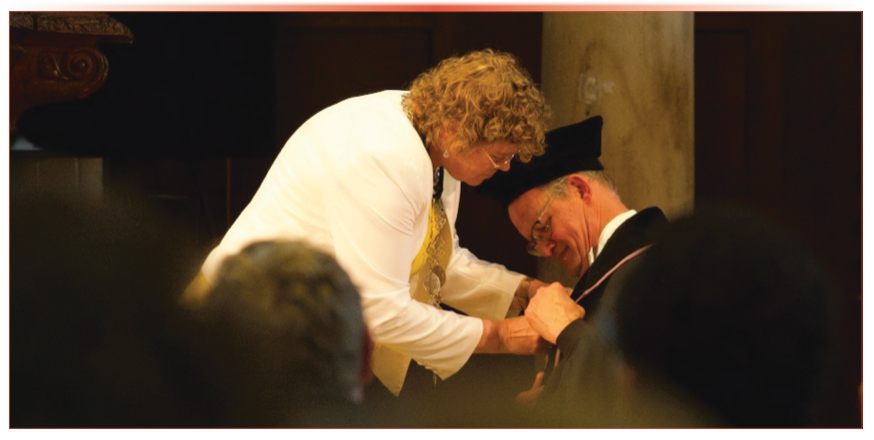
Main Research Fields
The broad range of areas where Schoenmakers has made important contributions includes:
- Gas chromatography (GC)
- Pioneering development of multi-dimensional GC (two-dimensions [2D])
- Size exclusion chromatography (SEC)
- Multi-angle laser light scattering (MALLS)
- Liquid chromatography (LC)
- Theory of gradient elution in reversed-phase LC (RPLC)
- Optimization of RPLC
- Analysis of polymers
- Pioneering development of multidimensional LC (two- and three-dimensions)
- Comprehensive two-dimensional LC (2D-LC)
- Molecular-topology fractionation
- Pyrolysis GC–mass spectrometry (Py-GC–MS)
- Nanotechnology (chip-based separations)
- Data handling and chemometrics
- Forensic analytical chemistry
Most Important Work
Schoenmakers is the author of more than 300 publications, has presented more than 300 talks, and has given approximately 800 poster presentations. Table II lists Schoenmakers’s papers that are highlighted in this article. An assessment of the impact of his career highlights several main areas for his research career.
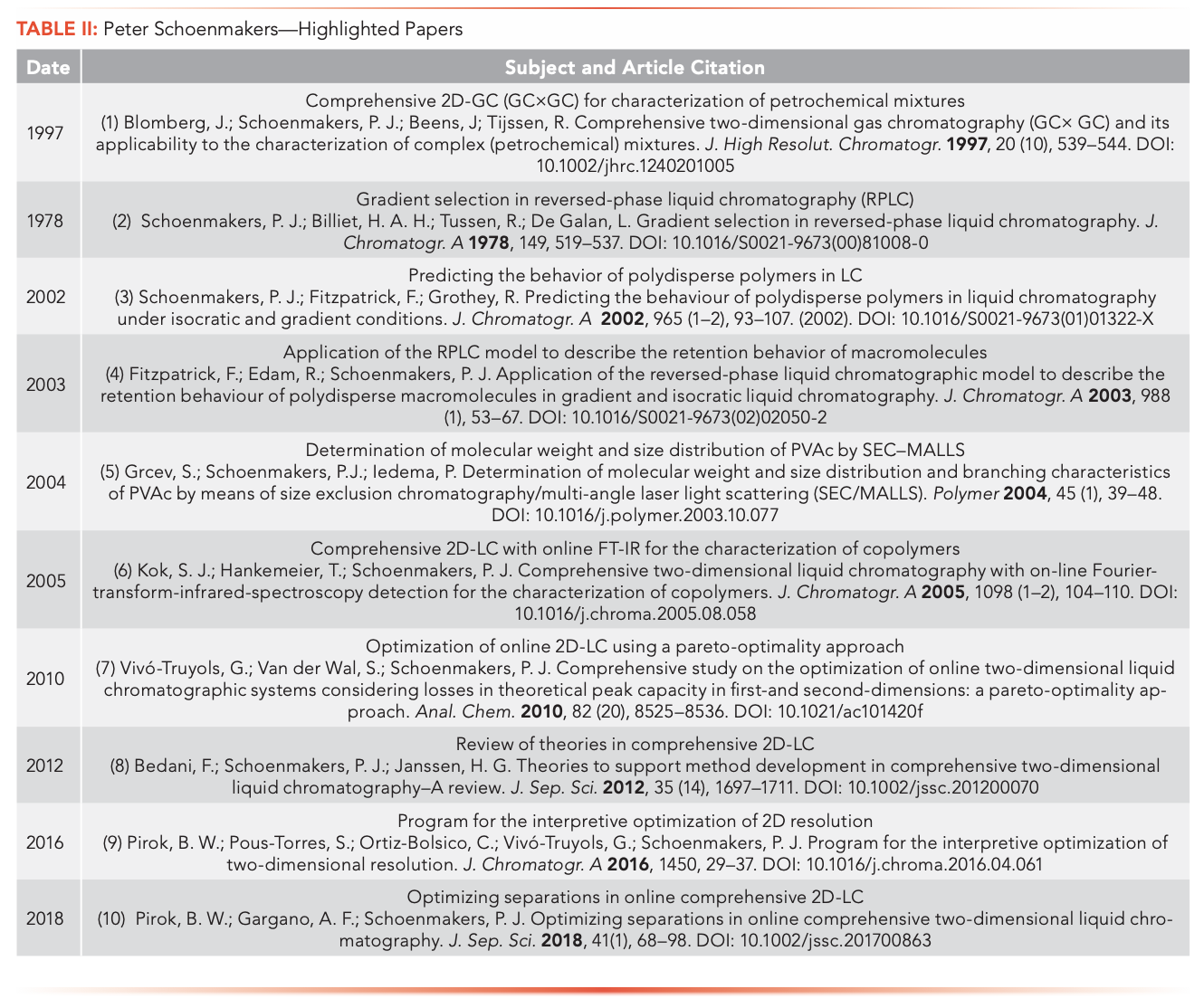
Early Work in GC
Schoenmakers’s work in GC before 1997 involves comprehensive 2D-GC (1), and has been cited approximately 250 times. This work described how the compositional analysis of hydrocarbon mixtures using 2D-GC is far superior to methods using 1D-GC.
Retention Time Modeling in RPLC
“Peter’s greatest contribution is without any doubt his early papers on retention time modeling and the influence of the organic phase in RPLC,” said Hans-Gerd Janssen, a prominent analytical scientist at Unilever and Wageningen University who studied with Schoenmakers. Indeed, Schoenmakers’s early work in RPLC received considerable attention, being cited over 300 times (2). This early work focused on generalizing a theory of gradient elution in LC, and provided a strategy for selecting an optimal gradient in RPLC from two viewpoints. First, a general expression was derived for the numerical calculation of retention when the relationship between the capacity factor, k, and the mobile-phase composition, φ, is known. Secondly, multicomponent solubility parameter theory was used to predict the relationship between k and φ. This work also addressed the essential variables to improve the accuracy of the predictions made.
Polymer Characterization
Schoenmakers’s work in polymer characterization also stands out, both in terms of the fundamentals of separation techniques and their applications. His initial work in this area described the use of SEC and RPLC for characterizing polydisperse polymers (3,4). These papers examined how the existing theories of chromatographic behavior with respect to retention times and peak width for isocratic and gradient-elution LC could be expanded to predict the separation behavior of polydisperse macromolecules, such as natural and synthetic repetitive polymers.
A pensive look in November 2022 as Schoenmakers listens during a formal public PhD defense at the University of Amsterdam (November 2022).
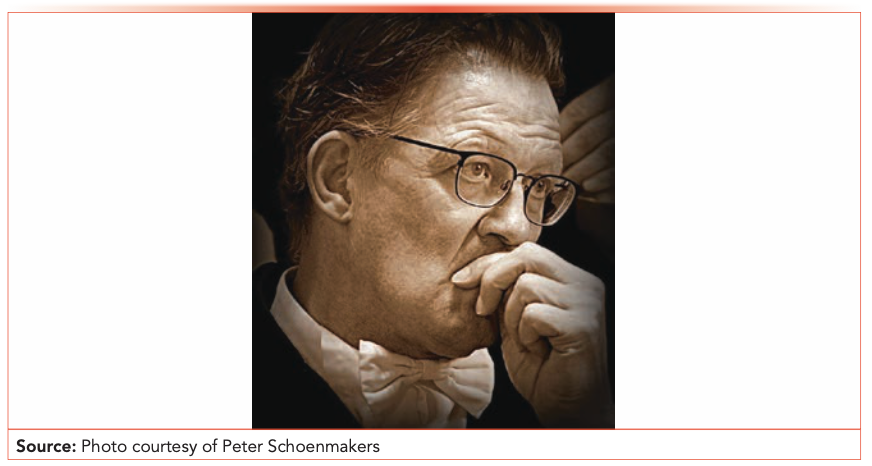
He expanded this research to include the use of multiple detector types and detector configurations, including SEC with multi-angle laser light scattering (SEC/MALLS) (5), and online Fourier transform infrared spectroscopy (FT-IR) detection (6). Schoenmakers also expanded his work in complex mixture and polymer characterization by applying multidimensional chromatography (6–10). “I would consider Peter’s most significant technical contributions to be in the area of multidimensional macromolecular separations,” said André M. Striegel of the U.S. National Institute of Standards and Technology (NIST).
Multidimensional LC (2D and 3D)
For many, however, what stands out the most about Peter Schoenmakers and his career is his pioneering work in multidimensional LC.
“Peter’s most significant contributions to the field of separation sciences relate to his pioneering developments of comprehensive two- and spatial three-dimensional liquid chromatographic concepts and their technical realization,” said Wolfgang Lindner, who is a professor at the University of Vienna in Austria and a lifelong friend and colleague since the time they studied with Barry Karger at Northeastern University.
Karger—who has followed Schoenmakers’s work since the 1970s when Schoenmakers spent time in Karger’s laboratory—agrees. “He is a leader in two- and three-dimensional chromatography,” he said.
A photo taken at the 39th International HPLC conference in Amsterdam in 2013. From left to right: Peter Schoenmakers, Barry Karger, Wolfgang Lindner, and Nobuo Tanaka. The four distinguished chromatographers include Karger and those who worked in Karger’s laboratory at the same time in 1978.
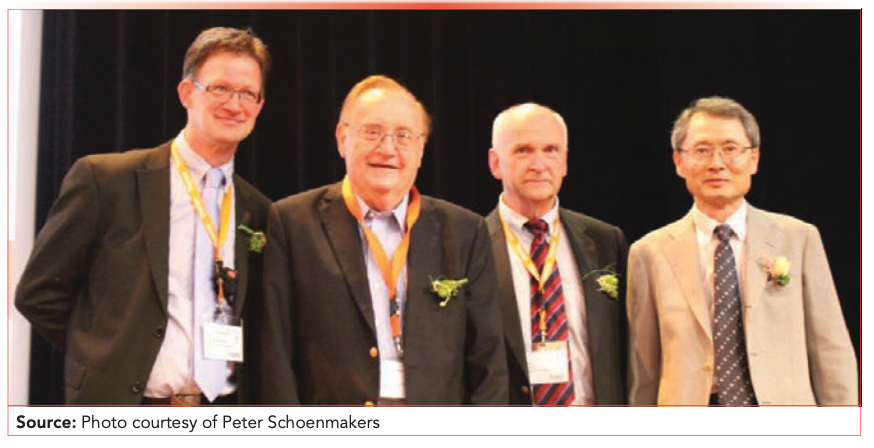
Four of his papers (7–10) in particular exemplify his work in 2D-LC. In a 2010 paper (7), Schoenmakers and coworkers developed a method for optimizing total analysis time, total peak capacity, and total dilution for comprehensive 2D-LC. The approach is based on Pareto-optimality for estimating optimal parameters for column particle sizes and column diameters. This paper formally recognized the Pareto optimality approach to improving analysis parameters, and it recognized that dilution is an important variable to consider for analysis optimization.
Organizational and working team for HPLC 2013: The 39th International Symposium on High Performance Liquid Phase Separations and Related Techniques, June 16–20 2013, in Amsterdam, Netherlands. HPLC 2013 in Amsterdam was made possible by a large “workforce” led by Petra Aarnoutse (middle, in front of Peter Schoenmakers, who is in the third row from bottom, second from left).

In 2018, Schoenmakers’s group published a review of the recent progress to optimize analytical parameters for online 2D-LC. The goal of this review was to provide chromatographers with a clear understanding of which analytical parameters, including sampling time, can be optimized using current strategies and the rationale for implementing different optimization approaches (8).
Schoenmakers and his colleagues also developed a program for the systematic optimization of 2D-LC separations, using gradient elution in both dimensions (9). This program was successfully applied to a separation problem consisting of a mixture of 54 aged, synthetic dyestuffs, separated by ion-exchange chromatography and ion pair chromatography. Schoenmakers has continued to explore the rationale and principles of 2D-LC chromatography experiments, expanding the knowledge base of strategies to improve the quality of two-dimensional liquid chromatography separations (10).
Service to the Scientific Community
In his work at the University of Amsterdam since 1998, Schoenmakers has taught many different chemistry courses and has advised the research of numerous university students—whom he generously encourages—in addition to teaching over 500 students in his short courses. “He has done a great job in training a large number of PhD students,” affirms Karger. “Peter’s career is about good science and educating the next generations of people to continue good science,” Janssen said.
Karger also noted the impact of Schoenmakers’s role in conferences. “He has been a major force on several of the key international meetings on chromatography,” he said.
Striegel of NIST agrees. “Peter’s personal contributions have been in organizing meetings and bringing together scientists from around the world, and in tirelessly promoting his students,” he said.
Indeed, Schoenmakers has been active in conference organization as a member of the Permanent Scientific Committee of the symposium series on High-Performance Liquid-Phase Separations and Related Techniques (HPLC), including chairing HPLC 2013 in Amsterdam, and as chairman of the organizing committee of the series of International Symposia on the Separation and Characterization of Natural and Synthetic Macromolecules (SCM; Amsterdam, 2003, 2005, 2007, 2009, 2011, 2015, and 2017; Dresden, Germany 2013). He has also chaired or helped to organize multiple other conferences and symposia.
Schoenmakers’s impact at conferences is also notable at the podium, as he sprinkles his discussions with scientific jokes, delivered in a quiet, deadpan fashion and supported by funny graphics. “He presents with a humorous and engaging speaking style,” said Peter W. Carr, a professor at the University of Minnesota. Karger agrees. “Everyone always looks forward to Peter’s talks at international meetings,” he said, “He not only presents exciting results, but keeps the audience entertained with humorous ways of discussing the results.”
Peter Schoenmakers in the lab in 2017 with Charlotte Croes, one of the MSc students from a national talent program he started.

Schoenmakers’s service to the scientific community also include being an editor of the Journal of Chromatography A since 2003, where he has recruited new authors, increased the quality of published papers, and fostered relationships with reviewers. “As editor of the Journal of Chromatography A, Peter brought a fundamental understanding of both separation and polymer science to that publication’s stewardship,” Striegel said. Schoenmakers has also been a member of the A page panel (1996–2000) and Editorial Advisory Board (2001–2003) of the American Chemical Society journal Analytical Chemistry, and is on the editorial boards of Chromatographia, Journal of Separation Science, and LCGC.
References
(1) Blomberg, J.; Schoenmakers, P. J.; Beens, J; Tijssen, R. Comprehensive Two‐Dimensional Gas Chromatography (GC×GC) and its Applicability to the Characterization of Complex (Petrochemical) Mixtures. J. High Resolut. Chromatogr. 1997, 20 (10), 539–544. DOI: 10.1002/jhrc.1240201005
(2) Schoenmakers, P. J.; Billiet, H. A. H.; Tussen, R.; De Galan, L. Gradient Selection in Reversed-Phase Liquid Chromatography. J. Chromatogr. A 1978, 149, 519–537. DOI: 10.1016/S0021-9673(00)81008-0
(3) Schoenmakers, P. J.; Fitzpatrick, F.; Grothey, R. Predicting the Behaviour of Polydisperse Polymers in Liquid Chromatography Under Isocratic and Gradient Conditions. J. Chromatogr. A 2002, 965 (1–2), 93–107. (2002). DOI: 10.1016/S0021-9673(01)01322-X
(4) Fitzpatrick, F.; Edam, R.; Schoenmakers, P. J. Application of the Reversed-Phase Liquid Chromatographic Model to Describe the Retention Behaviour of Polydisperse Macromolecules in Gradient and Isocratic Liquid Chromatography. J. Chromatogr. A 2003, 988 (1), 53–67. DOI: 10.1016/S0021-9673(02)02050-2
(5) Grcev, S.; Schoenmakers, P. J.; Iedema, P. Determination of Molecular Weight and Size Distribution and Branching Characteristics of PVAc by Means of Size Exclusion Chromatography/Multi-Angle Laser Light Scattering (SEC/MALLS). Polymer 2004, 45 (1), 39–48. DOI: 10.1016/j.polymer.2003.10.077
(6) Kok, S. J.; Hankemeier, T.; Schoenmakers, P. J. Comprehensive Two-Dimensional Liquid Chromatography with On-line Fourier-Transform-Infrared-Spectroscopy Detection for the Characterization of Copolymers. J. Chromatogr. A 2005, 1098 (1–2), 104–110. DOI: 10.1016/j.chroma.2005.08.058
(7) Vivó-Truyols, G.; Van der Wal, S.; Schoenmakers, P. J. Comprehensive Study on the Optimization of Online Two-Dimensional Liquid Chromatographic Systems Considering Losses in Theoretical Peak Capacity in First-and Second-Dimensions: A Pareto-Optimality Approach. Anal. Chem. 2010, 82 (20), 8525–8536. DOI: 10.1021/ac101420f
(8) Bedani, F.; Schoenmakers, P. J.; Janssen, H. G. Theories to Support Method Development in Comprehensive Two‐Dimensional Liquid Chromatography–A Review. J. Sep. Sci. 2012, 35 (14), 1697–1711. DOI: 10.1002/jssc.201200070
(9) Pirok, B. W.; Pous-Torres, S.; Ortiz-Bolsico, C.; Vivó-Truyols, G.; Schoenmakers, P. J. Program for the Interpretive Optimization of Two-Dimensional Resolution. J. Chromatogr. A 2016, 1450, 29–37. DOI: 10.1016/j.chroma.2016.04.061
(10) Pirok, B. W.; Gargano, A. F.; Schoenmakers, P. J. Optimizing Separations in Online Comprehensive Two‐Dimensional Liquid Chromatography. J. Sep. Sci. 2018, 41 (1), 68–98. DOI: 10.1002/jssc.201700863
The Emerging Leader in Chromatography Award
The Emerging Leader in Chromatography Award recognizes the achievements and aspirations of a talented young separation scientist who has made strides early in their career toward the advancement of chromatographic techniques and applications (Table I).
Emanuela Gionfriddo, the 2023 winner, received her PhD in chemistry in 2013 at the University of Calabria, in Italy. Following work as a postdoctoral fellow and research associate at the University of Waterloo, in Canada, in 2018 she became an assistant professor of chemistry at the University of Toledo, in Ohio, where she is the founding member of the Dr. Nina McClelland Laboratory for Water Chemistry and Environmental Analysis.
Emanuela Gionfriddo of the University of Toledo
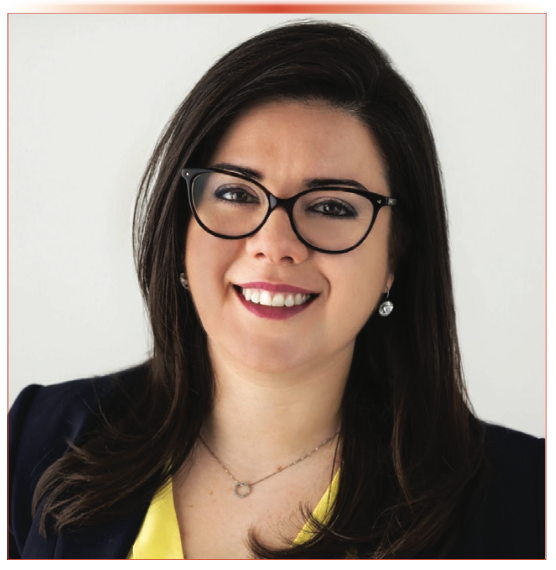
Gionfriddo received her BSc cum laude in 2008, her MSc cum laude in 2010, and her PhD in 2013—all degrees in chemistry from the University of Calabria in Arcavacata di Rende, Italy. From 2014 to 2017, she was a postdoctoral fellow and laboratory manager in the Industrially Focused Analytical Research Laboratory (InFAReL) of Professor Janusz Pawliszyn’s Research Group in the Department of Chemistry at the University of Waterloo in Ontario, Canada. Later in 2017, she became a research associate while maintaining her laboratory manager role at InFAReL. In 2018, she became an assistant professor at the Department of Chemistry and Biochemistry at The University of Toledo in Ohio, USA.
Gionfriddo’s work focuses on research and development of green microseparation methodologies for extraction of small molecules from complex mixtures, including biological and environmental samples. Her research is important for environmental analysis, for understanding the effects of environmental factors on human health (exposomics), and for metabolomics. Her research group is in active collaboration with several leading universities, as well as corporate research teams in the field of chromatography, including PerkinElmer, Gerstel, Supelco-Millipore Sigma, and Restek Corporation.
With more than 50 publications, Gionfriddo has given 60 oral and poster presentations. She has received several other awards, including a 2022 National Science Foundation CAREER Award, the 2022 Satinder Ahuja Award for Young Investigators in Separation Science from the American Chemical Society’s Analytical Chemistry Division, the 2022 University of Toledo President’s Award for Excellence in Creative and Scholarly Activities, and the UTC Excellence in Sample Prep Award at the North American Chemical Residue Workshop (NACRW) in 2018. She has also received the Young Author Prize at the International Symposium on Advances in Extraction Technologies (ExTech 2018), and best poster awards at the ExTech 2018, 2017, and 2016 conferences. In addition, Gionfriddo is part of the executive committee of the American Chemical Society subdivision for Chromatography and Separation Chemistry, as well as active in advising Ohio statewide authorities.
Most Influential and Cited Research Work
Most Cited Research
Gionfriddo’s most cited work underscores her keen attention to the development of solid-phase microextraction (SPME) techniques (11–15), As a side note, Gionfriddo’s father is a fragrance chemist, who has used SPME in his own research. “SPME became her passion since her father made her aware of this technique, and it is still driving her research,” Pawliszyn said. Her most highly cited SPME papers, with recent numbers of citations, appear in Table III.
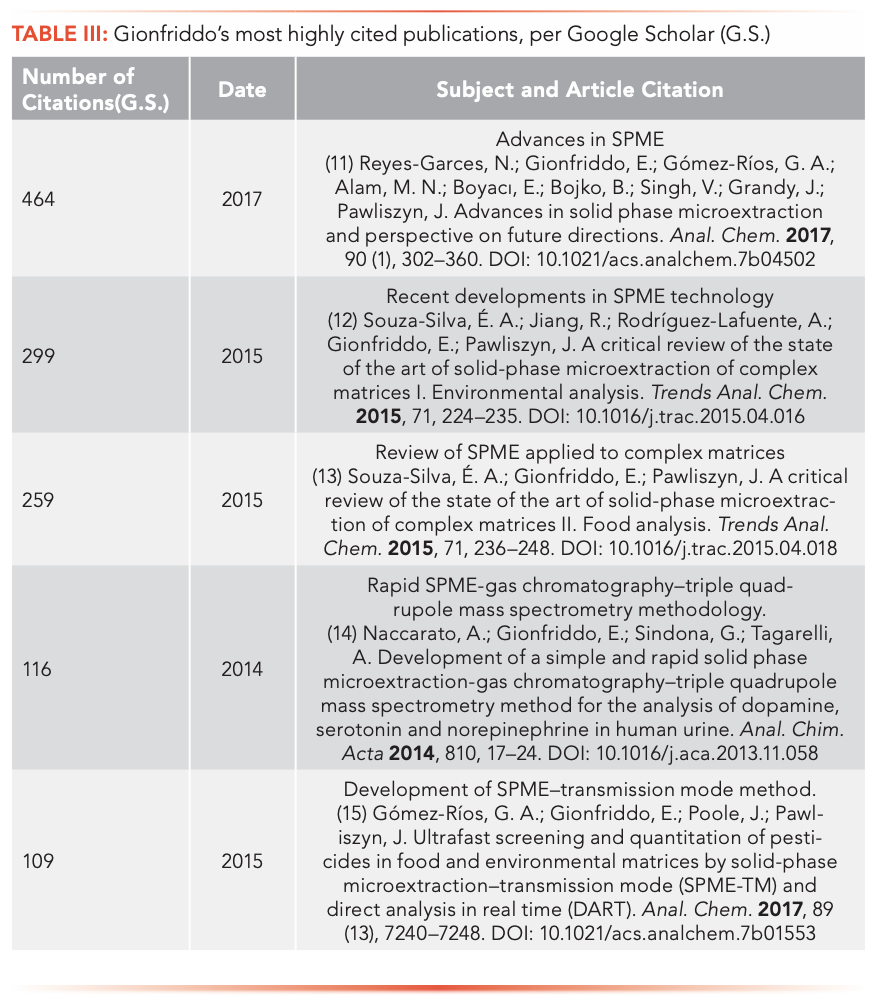
Advancing Environmental Analysis
One important area of research for Gionfriddo is the application of advanced extraction methods for environmental analysis. In one recent study, her research group investigated versatile extraction methods for the untargeted analysis of produced water (PW), which is a contaminated waste byproduct of oil and gas extraction (16). Using their specialized sample extraction methods combined with gas chromatography–mass spectrometry (GC–MS) analysis, they measured over 250 different organic compounds, including dioxane, atrazine, pyridine, and polycyclic aromatic hydrocarbons (PAHs). Elemental analysis was demonstrated for PW by applying dispersive solid-phase extraction along with inductively coupled plasma–mass spectrometry (ICP–MS), confirming the presence of multiple elements including rare earths, and hazardous metals such as Cr, Cd, Pb, and U. When these data were analyzed using partial least squares–discriminant analysis (PLS-DA), the geochemical origin of PW was achieved with a prediction accuracy above 90% indicating a potential method for PW origin tracing—an important ability for holding polluters responsible for environmental contamination.
Gionfriddo and colleagues also have described the details of a thin-film SPME method to assist in the analysis of produced water (PW) (17). The thin-film device they have developed enabled the reproducible analysis of PW without sample pretreatment. This approach was able to characterize approximately 200 compounds from PW samples where GC–MS and data deconvolution were used for analysis.
In another study, SPME was assessed by Gionfriddo as a preconcentration technique to aid the quantitation of per- and polyfluoroalkyl substances (PFAS) in drinking water at ppt levels, below the EPA method 533 established advisory limits (18). Four model PFAS compounds with varying physicochemical properties were evaluated for this feasibility study. Ultrahigh-pressure liquid chromatography–laminar flow tandem mass spectrometry (UHPLC–MS/MS) was also used for compound analysis. This method achieved LOQs of 2.5 ng/L for PFOS and 1 ng/L for GenX, PFBS, and PFOA, with acceptable precision and accuracy over a 5-day period.
Emmons and Gionfriddo also recently published a new method of sample introduction using SPME-Arrow-DART-MS (19). For the first time, an effective strategy was described for hyphenating SPME Arrow to mass spectrometry via a thermal desorption unit (TDU) and direct analysis in real time (DART) source. The developed method was optimized for the extraction and analysis of pesticides and pharmaceuticals from surface water. The method overcomes one of the limitations of ambient MS, especially for onsite analysis applications, which is the irreproducibility of the measurements related to the occurrence of transient microenvironments and variable background interferences.
Gionfriddo’s group in 2021 at the University of Toledo. From left: Charlotte DeRosa (undergraduate researcher), Aghogho Abigail Olomukoro (PhD candidate), Cassidy Howard (undergraduate researcher), Emanuela Gionfriddo, Ronald Emmons (PhD candidate), Eden Rosales (undergraduate researcher), Noah Peterson (M.Sc. student), Nipunika H. Godage (PhD candidate), Nicole Usserman (undergraduate researcher).

New Tools for Metabolomics and Exposomics
In another area of her work, metabolomics, Gionfriddo’s team quantified nicotine and its metabolites in rabbit plasma using SPME-LC–MS/MS, while applying a dual fiber extraction approach that enabled analyte extraction at ppt levels, in a 2020 study (20). This research demonstrated the ultratrace determination of nicotine and its four major metabolites (cotinine, nornicotine, norcotinine, and anabasine) from rabbit plasma.
Gionfriddo presenting a corsage to Dr. Nina McClelland at the beginning of the dedication ceremony on September 19, 2019, for the Dr. Nina McClelland Laboratory for Water Chemistry and Environmental Analysis at the University of Toledo in Ohio.

Gionfriddo presenting a corsage to Dr. Nina McClelland at the beginning of the dedication ceremony on September 19, 2019, for the Dr. Nina McClelland Laboratory for Water Chemistry and Environmental Analysis at the University of Toledo in Ohio.
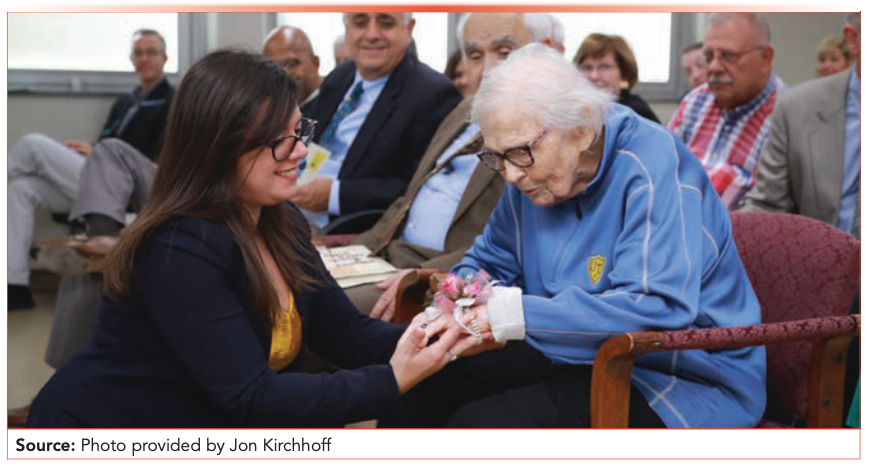
In another metabolomics study, Gionfriddo, Boyaci, and Pawliszyn presented a new generation of SPME coatings based on polytetrafluoroethylene amorphous fluoroplastics (PTFE AF 2400) (21). This new SPME approach may be used with both gas- and liquid chromatography and was demonstrated for determination of banned doping substances, achieving limits of quantitation below the minimum required performance limits (MRPLs) set by the World Anti-Doping Agency (WADA) for most compounds.
In a 2022 research paper, the Gionfriddo group described a method to improve the quantitative analysis of the neurotoxin β-N-methylamino-L-alanine (BMAA) and its isomers. Chromatographic separation was achieved in 8 min on a fluorophenyl stationary phase, ensuring high throughput without derivatization, and showing exceptional improvement from conventional hydrophilic interaction chromatography (HILIC) methods (22). In another study, Godage and Gionfriddo proposed a new method for biomonitoring studies focused on the screening and quantification of xenobiotics in blood-derived samples (23). The performance of a polydimethylsiloxane/divinylbenzene/polydimethylsiloxane (PDMS/DVB/PDMS) biocompatible extraction phase was investigated for extraction of pesticides and pharmaceuticals from plasma samples via direct immersion SPME prior to GC–MS.
Conference dinner at The 43rd International Symposium on Capillary Chromatography (ISCC) and the 16th GC×GC symposium (May 12 – 17, 2019) in Fort Worth, Texas USA.
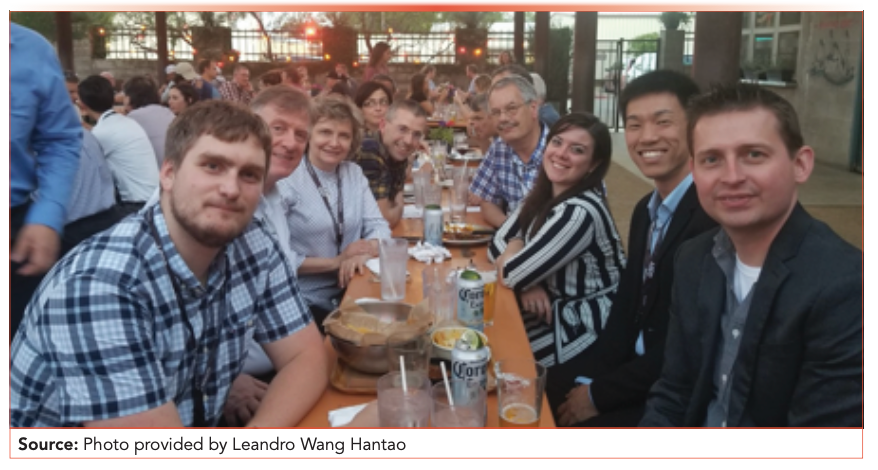
An Outstanding Researcher, Teacher, and Leader
Gionfriddo’s activities have had a positive impact on her colleagues and students, and her skills, passion for science, and community involvement make her stand out. “Emanuela exhibits great soft skills, which makes her laboratory a very pleasant and an amazing environment for research and innovation,” said Leandro Wang Hantao, an assistant professor at the University of Campinas in Brazil. “She is definitely a potential leader in her field of research.”
“Dr. Gionfriddo is an exceptional colleague and contributor to the department, the University of Toledo, and the profession,” said Jon Kirchhoff, a Distinguished University Professor and Chair of the Department of Chemistry & Biochemistry at the University of Toledo in Ohio. He noted that Gionfriddo “has distinguished herself as an outstanding teacher, mentor, colleague, researcher, and role model for her students, especially young women in STEM fields.” He also remarked on the rapid development of her laboratory. “In just over 4.5 years, Dr. Gionfriddo has created at the University of Toledo a state-of-the-art separation science laboratory,” he said. This laboratory is a combination of separation science and mass spectrometry instrumentation used for her research program and the training of her students into the future.
“Emanuela is not only a great researcher, but also a great teacher,” said James Grinias, an associate professor at Rowan University and the 2022 LCGC Emerging Leader in Chromatography Award recipient. He also notes that although Gionfriddo’s training was as a fundamental separation scientist, she actively collaborates with researchers in other fields, such as mass spectrometry and environmental science. “I think her collaboration has helped her immensely, as it allows her to expand her sample preparation expertise into a number of application areas,” he said. “I also think it should be noted that Emanuela is an outstanding mentor who is working extremely hard to develop the next generation of separation scientists.”
Kevin Schug, a professor at The University of Texas at Arlington, summarized the combination of Gionfriddo’s scientific skills, work ethic, and personality. “Emanuela is an expert in sample preparation for trace chemical analysis,” he said. “She is also a warm and caring individual, and she approaches science as fun and full of opportunities.”
References
(11) Reyes-Garces, N.; Gionfriddo, E.; Gómez-Ríos, G. A.; Alam, M. N.; Boyacı, E.; Bojko, B.; Singh, V.; Grandy, J.; Pawliszyn, J. Advances in Solid Phase Microextraction and Perspective on Future Directions. Anal. Chem. 2017, 90 (1), 302–360. DOI: 10.1021/acs.analchem.7b04502
(12) Souza-Silva, É. A.; Jiang, R.; Rodríguez-Lafuente, A.; Gionfriddo, E.; Pawliszyn, J. A Critical Review of the State of the Art of Solid-Phase Microextraction of Complex Matrices I. Environmental Analysis. Trends Anal. Chem. 2015, 71, 224–235. DOI: 10.1016/j.trac.2015.04.016
(13) Souza-Silva, É. A.; Gionfriddo, E.; Pawliszyn, J. A Critical Review of the State of the Art of Solid-Phase Microextraction of Complex Matrices II. Food Analysis. Trends Anal. Chem. 2015, 71, 236–248. DOI: 10.1016/j.trac.2015.04.018
(14) Naccarato, A.; Gionfriddo, E.; Sindona, G.; Tagarelli, A. Development of a Simple and Rapid Solid Phase Microextraction-Gas Chromatography–Triple Quadrupole Mass Spectrometry Method for the Analysis of Dopamine, Serotonin and Norepinephrine in Human Urine. Anal. Chim. Acta 2014, 810, 17–24. DOI: 10.1016/j.aca.2013.11.058
(15) Gómez-Ríos, G. A.; Gionfriddo, E.; Poole, J.; Pawliszyn, J. Ultrafast Screening and Quantitation of Pesticides in Food and Environmental Matrices by Solid-Phase Microextraction–Transmission Mode (SPME-TM) and Direct Analysis in Real Time (DART). Anal. Chem. 2017, 89 (13), 7240–7248. DOI: 10.1021/acs.analchem.7b01553
(16) Emmons, R.V.; Shyam Sunder, G.S.; Liden, T.; Schug, K.A.; Asfaha, T.Y.; Lawrence, J. G.; Kirchhoff, J. R.; Gionfriddo, E. Unraveling the Complex Composition of Produced Water by Specialized Extraction Methodologies. Environ. Sci. Technol. 2022, 56 (4), 2334–2344. DOI: 10.1021/acs.est.1c05826
(17) Emmons, R. V.; Liden, T.; Schug, K. A.; Gionfriddo, E. Optimization of Thin Film Solid Phase Microextraction and Data Deconvolution Methods for Accurate Characterization of Organic Compounds in Produced Water. J. Sep. Sci. 2020, 43 (9–10), 1915–1924. DOI: 10.1002/jssc.201901330
(18) Olomukoro, A. A.; Emmons, R. V.; Godage, N. H.; Cudjoe, E.; Gionfriddo, E. Ion Exchange Solid Phase Microextraction Coupled to Liquid Chromatography/Laminar Flow Tandem Mass Spectrometry for the Determination of Perfluoroalkyl Substances in Water Samples. J. Chromatogr. A 2021, 1651, 462335. DOI: 10.1016/j.chroma.2021.462335
(19) Emmons R. V.; Gionfriddo, E. Minimizing Transient Microenvironment- Associated Variability for Analysis of Environmental Anthropogenic Contaminants via Ambient Ionization. Sci. Total Environ. 2021, 775, 145789. DOI: 10.1016/j.scitotenv.2021.145789
(20) Godage, N. H.; Cudjoe, E.; Neupane, R.; Boddu, S. H.; Bolla, P. K.; Renukuntla, J.: Gionfriddo, E. Biocompatible SPME fibers for Direct Monitoring of Nicotine and its Metabolites at Ultra-Trace Concentration in Rabbit Plasma Following the Application of Smoking Cessation Formulations. J. Chromatogr. A 2020, 1626, 461333. DOI: 10.1016/j.chroma.2020.461333
(21) Gionfriddo, E.; Boyaci, E.; Pawliszyn, J. New Generation of Solid-Phase Microextraction Coatings for Complementary Separation Approaches: a Step Toward Comprehensive Metabolomics and Multiresidue Analyses in Complex Matrices. Anal. Chem. 2017, 89 (7), 4046–4054. DOI: 10.1021/acs.analchem.6b04690
(22) Emmons, R. V.; Karaj, E.; Cudjoe, E.; Bell, D. S.; Tillekeratne, L. V.; Gionfriddo, E. Leveraging Multi-Mode Microextraction and Liquid Chromatography Stationary Phases for Quantitative Analysis of Neurotoxin β-N- methylamino-L-alanine and Other Non-Proteinogenic Amino Acids. J. Chromatogr. A 2022, 1685, 463636. DOI: 10.1016/j.chroma.2022.463636
(23) Godage. N. H.; Gionfriddo, E. Biocompatible SPME Coupled to GC/ MS for Analysis of Xenobiotics in Blood Plasma. J. Chromatogr. B 2022, 1203, 123308. DOI: 10.1016/j.jchromb.2022.123308
Jerome Workman, Jr. is Senior Technical Editor for LCGC North America. Direct correspondence about this article to: jworkman@mjhlifesciences.com.
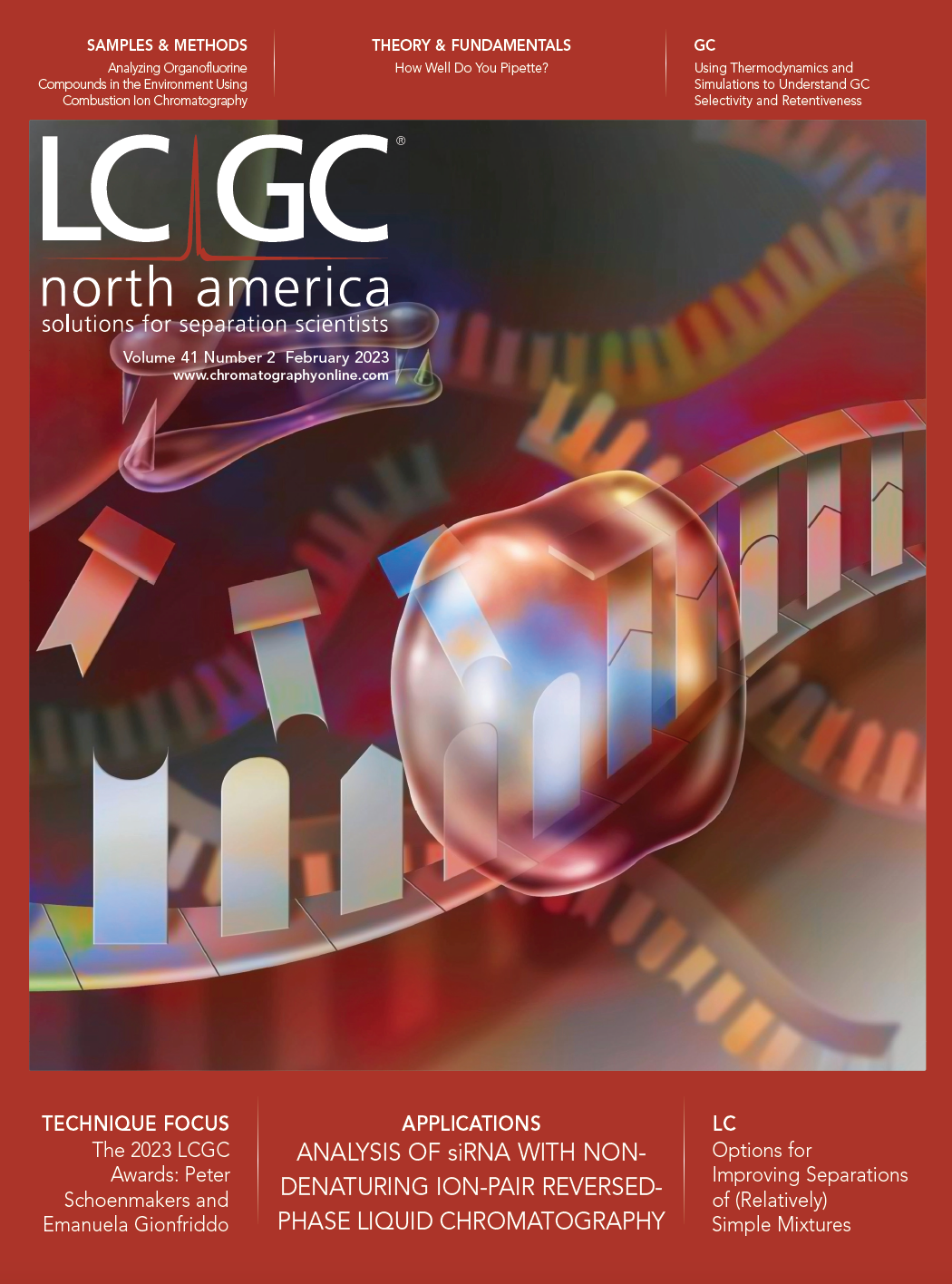
Polysorbate Quantification and Degradation Analysis via LC and Charged Aerosol Detection
April 9th 2025Scientists from ThermoFisher Scientific published a review article in the Journal of Chromatography A that provided an overview of HPLC analysis using charged aerosol detection can help with polysorbate quantification.
Removing Double-Stranded RNA Impurities Using Chromatography
April 8th 2025Researchers from Agency for Science, Technology and Research in Singapore recently published a review article exploring how chromatography can be used to remove double-stranded RNA impurities during mRNA therapeutics production.













